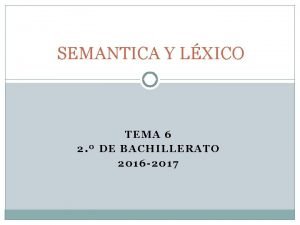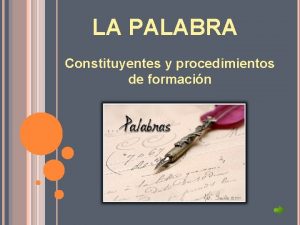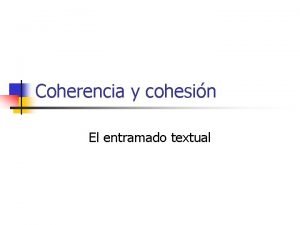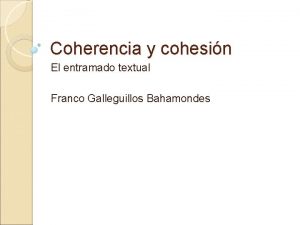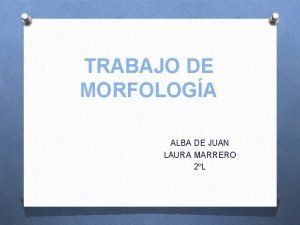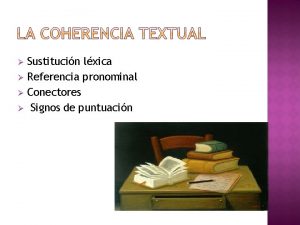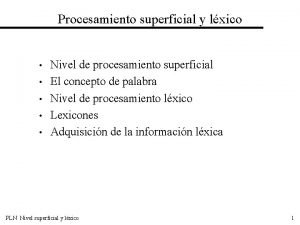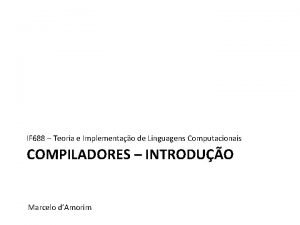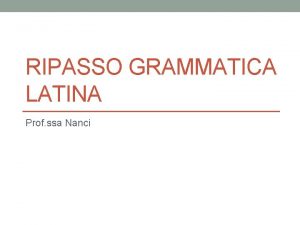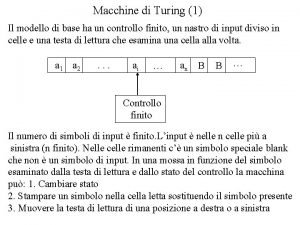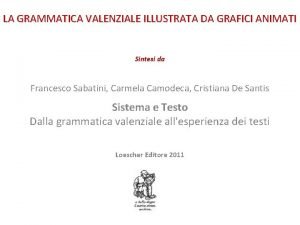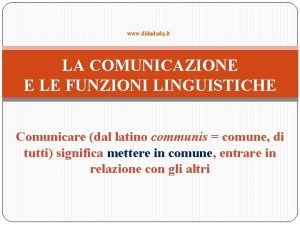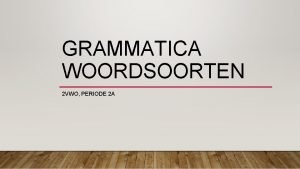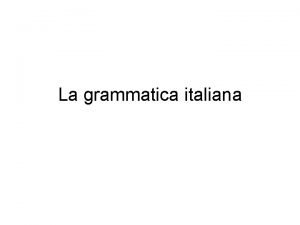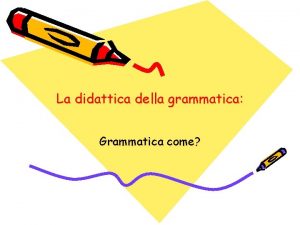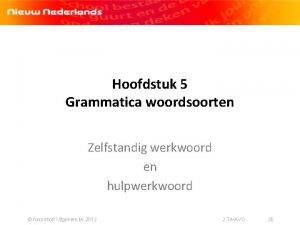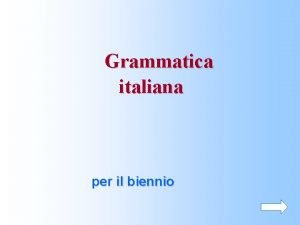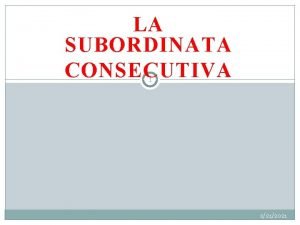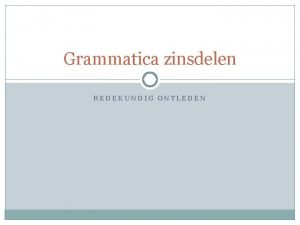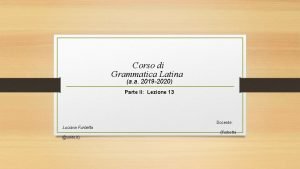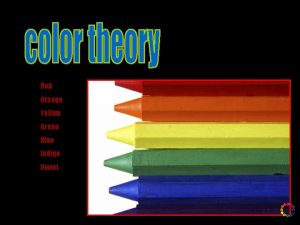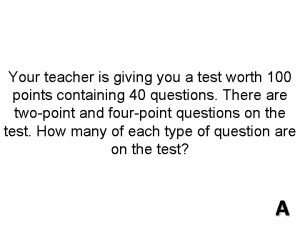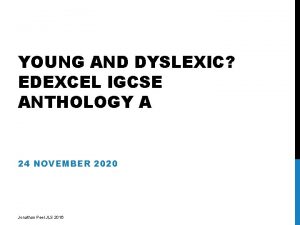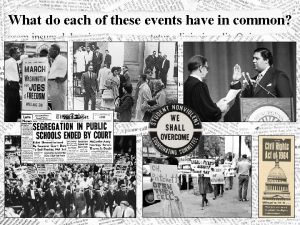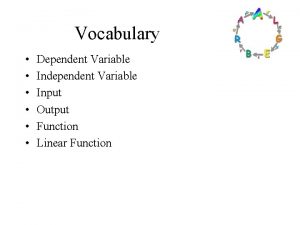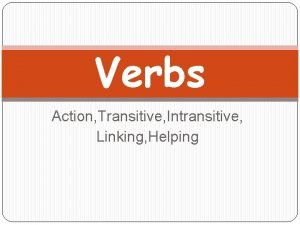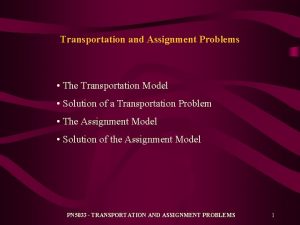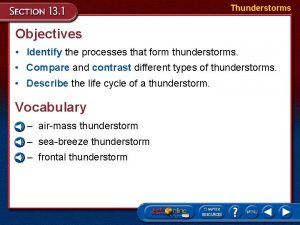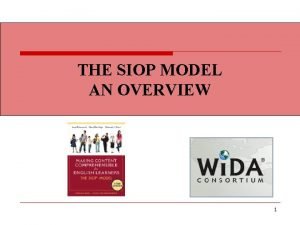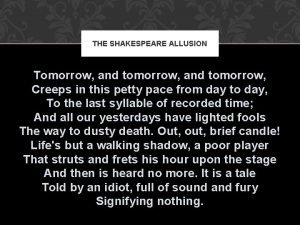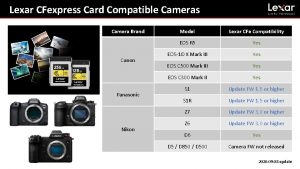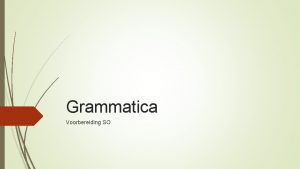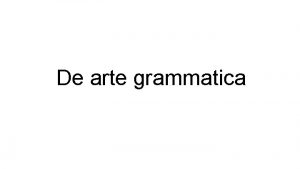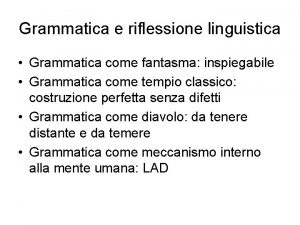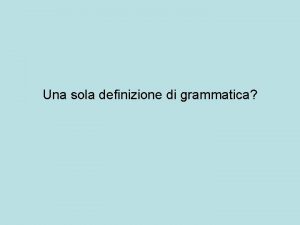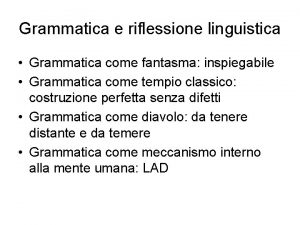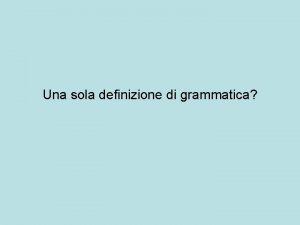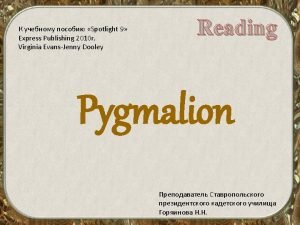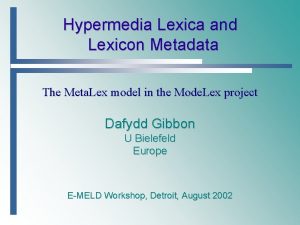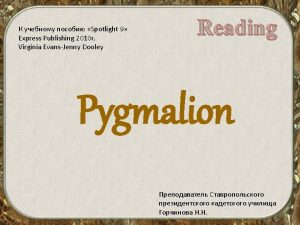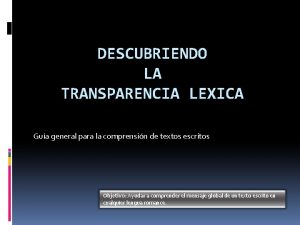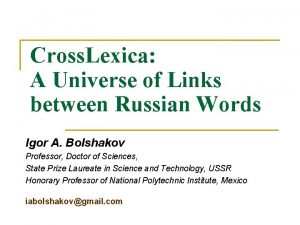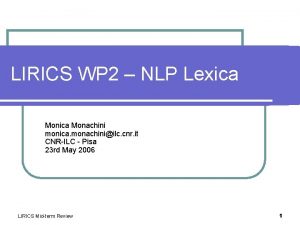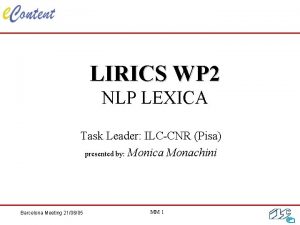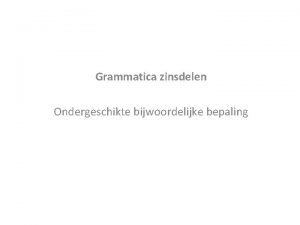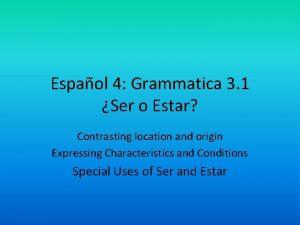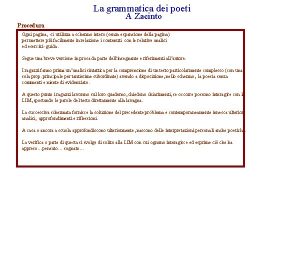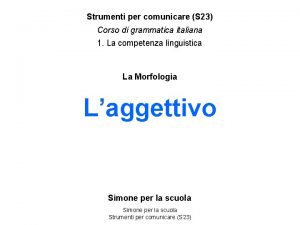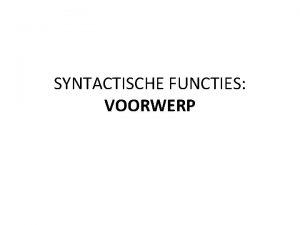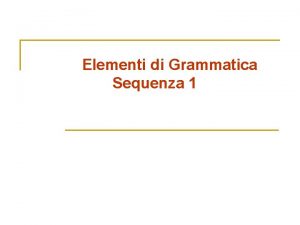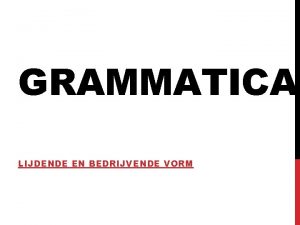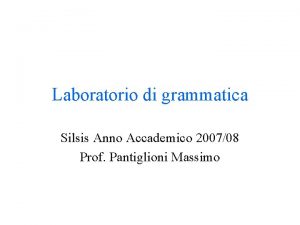Grammatica GRAMMATICa Lexica GRAMMATICa Lexica LEXAR and GRAMICON















![[CP Spec [C’ C [IP Spec [I’ I VP]]]] “Items of the lexicon are [CP Spec [C’ C [IP Spec [I’ I VP]]]] “Items of the lexicon are](https://slidetodoc.com/presentation_image_h/78fcc1c0d2200e5cedf24ff554eab0cc/image-16.jpg)





















![Ray Jackendoff on the Lexicon-Grammar Interface Semantic Structures (1990) “To develop [a] more general Ray Jackendoff on the Lexicon-Grammar Interface Semantic Structures (1990) “To develop [a] more general](https://slidetodoc.com/presentation_image_h/78fcc1c0d2200e5cedf24ff554eab0cc/image-38.jpg)
![eat V [CAUSE ([Thing ] A’ [GO ([Thing ] <A’> [TO [IN [MOUTH-OF [ eat V [CAUSE ([Thing ] A’ [GO ([Thing ] <A’> [TO [IN [MOUTH-OF [](https://slidetodoc.com/presentation_image_h/78fcc1c0d2200e5cedf24ff554eab0cc/image-39.jpg)












- Slides: 51


Grammatica

GRAMMATICa Lexica

GRAMMATICa Lexica


LEXAR and GRAMICON Mutant Children of the Revolution Sally Rice Décade I, Nonidi de Germinal de l'Année CCXIV de la Revolution 29 March 2006

LEXAR and GRAMICON Mutant Children of the Revolution Sally Rice Décade I, Nonidi de Germinal de l'Année CCXIV de la Revolution 29 March 2006

the age of enlightenmen t

the age of enlightenmen t





“We distinguish the lexicon from the computational system of the language, the syntax in a broad sense (including phonology). Assume that the syntax provides three fundamental levels of representation, each constituting an ‘interface’ of the grammatical system with some other system of the mind/brain: D-Structure, Phonetic Form (PF), and Logical Form (LF). ” Chomsky 1995: 130

“Any theory of language must include some sort of lexicon, the repository of all (idiosyncratic) properties of particular lexical items. . . The lexicon is a set of lexical elements, each an articulated system of features. It must specify, for each such element, the phonetic, semantic, and syntactic properties that are idiosyncratic to it, but nothing more. ” Chomsky 1995: 30. 130
![CP Spec C C IP Spec I I VP Items of the lexicon are [CP Spec [C’ C [IP Spec [I’ I VP]]]] “Items of the lexicon are](https://slidetodoc.com/presentation_image_h/78fcc1c0d2200e5cedf24ff554eab0cc/image-16.jpg)
[CP Spec [C’ C [IP Spec [I’ I VP]]]] “Items of the lexicon are of two general types: with or without substantive content. We restrict the term lexical to the former category; the latter are functional. Each item is a feature set. Lexical elements head NP, VP, AP, and PP. ” Chomsky 1995: 54

4. 2. 2 The Lexicon I will have little to say about the lexicon here. Chomsky 1995: 235 “The lexical entry provides. . . the information required for further computations. ” Chomsky 1995: 130




1789

1989

LAUD Conference on Cognitive Linguistics, Universität Duisburg 1989

LAUD Conference on Cognitive Linguistics, Universität Duisburg Les sansculottes

Ron Langacker “A grammar is a structured inventory of conventional linguistic units. ”

Len Talmy

George Lakoff (a. k. a. Robespierre)






Towards more Republican Values

REFORM or REVOLUTION? “Whenever a change leaves the internal mechanism untouched, we have reform; whenever the internal mechanism is changed, we have revolution. ” Daniel De. Leon, 1896, in address to the Workingmen of Boston

The Reformers

Ken Hale on LEXAR/GRAMICON items in Navajo

ch’ɪ -shi-di-nɪ -ɫ-da zh out-1 SG. O-QUAL-3 SG. MOM-TRANSuncontrolled. movement ‘he jerked me out(side)’
![Ray Jackendoff on the LexiconGrammar Interface Semantic Structures 1990 To develop a more general Ray Jackendoff on the Lexicon-Grammar Interface Semantic Structures (1990) “To develop [a] more general](https://slidetodoc.com/presentation_image_h/78fcc1c0d2200e5cedf24ff554eab0cc/image-38.jpg)
Ray Jackendoff on the Lexicon-Grammar Interface Semantic Structures (1990) “To develop [a] more general theory of language (concerned with syntax and semantics and their points of connection), one must confront two basic problems, which might be called the Problem of Meaning and the Problem of Correspondence. ” “The Problem of Meaning is to characterize the phenomena that a theory of meaning is to account for, and to develop a formal treatment of semantic intuitions. ” “The Problem of Correspondence is to characterize the relationship between the formal treatment of meaning and the formal structure of syntax. ”
![eat V CAUSE Thing A GO Thing A TO IN MOUTHOF eat V [CAUSE ([Thing ] A’ [GO ([Thing ] <A’> [TO [IN [MOUTH-OF [](https://slidetodoc.com/presentation_image_h/78fcc1c0d2200e5cedf24ff554eab0cc/image-39.jpg)
eat V [CAUSE ([Thing ] A’ [GO ([Thing ] <A’> [TO [IN [MOUTH-OF [ ]]]])])]) devour V [CAUSE ([Thing ] A’ [GO ([Thing ] A’ [TO [IN [MOUTH-OF [ ]]]])])])




The Revolutionaries

Cognitive & Construction Grammarians looking at constructions as the basic building blocks of language

Corpus Linguists looking at N-grams, collocates, and collostructions

Language Teachers who teach collocations

Developmentalists and Computational Linguists looking at emergent structures in language such as lexical islands and lexical bundles




Won’t you join the Revolution?
 Campo semantico de bailarinas
Campo semantico de bailarinas Familia lexica de lobo
Familia lexica de lobo Cohesión lexica
Cohesión lexica Cohesión lexica
Cohesión lexica Campo semantico de silla
Campo semantico de silla Cohesión lexica
Cohesión lexica Familia de palabras de vivir
Familia de palabras de vivir Referencia prenominal
Referencia prenominal Familia léxica
Familia léxica Cohesion lexica
Cohesion lexica Nivel superficial
Nivel superficial Analise lexica
Analise lexica Declinazione lupus
Declinazione lupus Macchina di turing esempio
Macchina di turing esempio Frasi giustapposte
Frasi giustapposte Spelling en grammatica oefenen
Spelling en grammatica oefenen Giochi di grammatica
Giochi di grammatica Didada
Didada Oefenen met woordsoorten
Oefenen met woordsoorten Alle woordsoorten op een rij
Alle woordsoorten op een rij Wed vnw
Wed vnw Passato prossimo
Passato prossimo Grammatica induttiva esercizi
Grammatica induttiva esercizi Voorzetselvoorwerp
Voorzetselvoorwerp Zelfstandig werkwoord
Zelfstandig werkwoord Apodosi grammatica
Apodosi grammatica Concessive subordinate
Concessive subordinate Reggente grammatica
Reggente grammatica Wat is redekundig ontleden
Wat is redekundig ontleden Kww hww zww
Kww hww zww Grammatica zinsdelen
Grammatica zinsdelen Red yellow blue green purple orange black brown
Red yellow blue green purple orange black brown And because i am happy and dance and sing
And because i am happy and dance and sing West side story romeo and juliet worksheet
West side story romeo and juliet worksheet Taller and younger older and shorter
Taller and younger older and shorter How to write 1000 pesos
How to write 1000 pesos Blue red orange blue green red
Blue red orange blue green red Gabby and sydney bought some pens
Gabby and sydney bought some pens Young and dyslexic structure analysis
Young and dyslexic structure analysis Albany movement
Albany movement West yorkshire and harrogate health and care partnership
West yorkshire and harrogate health and care partnership Draw and label transverse wave
Draw and label transverse wave Compare and contrast spring and neap tides.
Compare and contrast spring and neap tides. X and y axis dependent and independent
X and y axis dependent and independent Action verbs and linking verbs
Action verbs and linking verbs Mention any four life roles and responsibilities
Mention any four life roles and responsibilities Records and reports in nursing
Records and reports in nursing Transportation and assignment problems
Transportation and assignment problems Compare and contrast cold wave and wind chill factor
Compare and contrast cold wave and wind chill factor Vertical format for trading profit and loss account
Vertical format for trading profit and loss account Language spanish
Language spanish Tomorrow creeps in this petty pace
Tomorrow creeps in this petty pace
